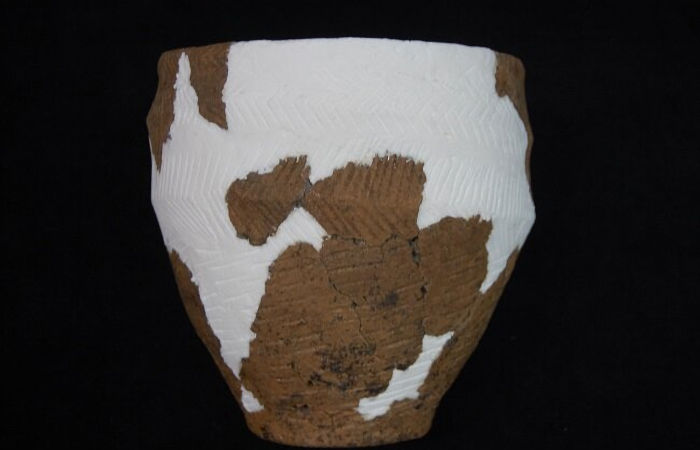Jan Bartek – AncientPages.com – A 5,000-year-old container, discovered behind a butcher’s shop, is being exhibited at Kirkcaldy Galleries having been recently conserved by experts. Conservation has been completed as part of a wider project to find out more about the human remains and objects found on Kirkcaldy High Street in June 1980.
Archaeologists from the University of Glasgow, who are leading the study, will use a range of scientific techniques not available to their predecessors who carried out the dig.

Bronze Age food vessel. Credit: University of Glasgow
Work to flatten the shop and a H๏τel 42 years ago was dramatically halted when a bulldozer driver caught sight of some partially buried bones. Three burial cists—or ancient coffins—emerged in the subsequent dig. Two held human remains that showed traces of burning and the other contained the vessel, a flint arrowhead and a flint knife.
The find is one of several 5,000-year-old discoveries to have been made in Kirkcaldy, suggesting that the area was an Early Bronze Age stronghold.
The patterned clay vessel was found in several pieces and reconstructed by University of Glasgow archaeologists at the time. All of the finds were added to the collection at Kirkcaldy Museum and Art Gallery—now known as Kirkcaldy Galleries—where they have been cared for by curators ever since.
Curators recently noticed the vessel had become unstable and, following analysis by the Glasgow archaeology team, conservation work began. Specialists at the Scottish Conservation Studio in Edinburgh have preserved and safeguarded the vessel using a reversible adhesive that allows the pot to be dismantled again, if need be.
The pot has been partially filled as only 75 percent of the original vessel survives. The adhesive used to fill it is slightly darker than the clay so visitors can tell where additions have been made. A grant from the Historic Environment Support Fund means post-excavation analysis of the other objects found at the site, as well as the human remains, can now go ahead. Following an initial appraisal in April, the artifacts have been transferred to a laboratory at the University of Glasgow where analysis will take place.
The study is one of several being undertaken by University of Glasgow archaeologists that will bring to a conclusion uncompleted projects begun by their predecessors
Jane Freel, a curator with the cultural charity OnFife, which manages the Kirkcaldy collections on behalf of Fife Council, says, “We’re thrilled that visitors can now see this magnificent object for themselves as it offers a fascinating glimpse into Kirkcaldy’s distant past.”
Dr. Marta Innes, who is part of the University of Glasgow archaeology team, says that “it’s a rare privilege to re-analyze an ancient object so many years after its discovery. We’re hopeful it will help us better understand the prehistoric life of the local area.”
See also: More Archaeology News
Dr. Nyree Finlay, a senior lecturer in Archaeology at The University of Glasgow and project lead of the “Digging Up Kirkcaldy’s Bronze Age Stories” project behind the new analysis says that “it is fantastic to see the newly-restored pot on public display. We look forward to sharing more untold stories about this discovery in a series of public events throughout the coming year as the research continues.”
Written by Jan Bartek – AncientPages.com Staff Writer





